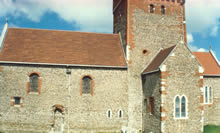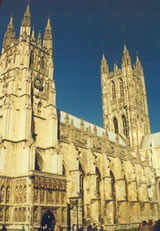General Introduction to the Medieval Period
The Medieval period is generally considered to extend from
the fifth century to the fifteenth century in Western Europe.
Living Conditions:
People tended to live in small communities and there was a central lord or master. This arrangement was necessary for safety and for defence. Most people lived on a manor. The manor was made up of the castle, the church, the village, and the surrounding farmland. Manors were typically isolated from the outside world but they occasionally received visitors from travelling peddlers or pilgrims on their way to the Crusades. This style of community is sometimes referred to as the "feudal" sy stem. The feudal system worked by the king giving land grants to his loyal servants. This included nobles, barons, and bishops. The land was a reward for their contributions to the king's armies. The peasants (who were called "serfs" or "villeins") were the lowest class of people within the community. Peasants could live and work on the lord of the manor's land but they were heavily taxed and they usually had to give the lord of the manor a sizable proportion of the food that they produced. Living conditions were difficult. For example, most medieval homes were cold, damp, and dark. This was partly because most houses were built without windows for added security.
stem. The feudal system worked by the king giving land grants to his loyal servants. This included nobles, barons, and bishops. The land was a reward for their contributions to the king's armies. The peasants (who were called "serfs" or "villeins") were the lowest class of people within the community. Peasants could live and work on the lord of the manor's land but they were heavily taxed and they usually had to give the lord of the manor a sizable proportion of the food that they produced. Living conditions were difficult. For example, most medieval homes were cold, damp, and dark. This was partly because most houses were built without windows for added security.
Health:
As the populations of medieval towns and cities increased, the hygienic conditions began to worsen this lead to an increase in the rate of diseases. Medical knowledge was limited and limited health care was available to the common people. Antibiotics were not invented until the 1800s and it was almost impossible to cure diseases without them. Many myths and superstitions about health and hygiene began to emerge. For example, people believed that disease was spread by bad odours and that if you got sick it was because you were being punished for your sins.
Clothing:
Most clothes wore made from wool and underwear was usually made from linen. If you were wealthy you would were bright colours and better quality fabrics to demonstrate your wealth. This meant that the clothing for the upper classes tended to be very ornate. Towards the end of the Middle Ages, men of the wealthy classes would wear a form of tights and a jacket or a tunic with a surcoat. Aristocratic women wore long flowing gowns and they always wore detailed headwear. Tall steeple caps were common but sometimes they were turbans or ornamental headdresses. Members of religious orders wore long woollen habits with the colour of the habit indicating which order they belonged to. The Benedictine order wore black and the Cistercians wore either natural-coloured wool or white.
The male serfs tended to wear stockings and tunics while the females wore long gowns with sleeveless tunics and wimples to cover their hair. People never washed the outer layers of clothes (but they usually washed the linen underwear). The Wealthy members of the community used fur to line their clothes for extra warmth. They also wore extravagant jewellery. Diamonds were popular throughout Europe in the fourteenth century.
The Role of Women:
The role that women played within the medieval community was primarily restricted to domestic duties including cooking, baking bread, sewing, weaving, and spinning.However, some women were permitted to hunt for food and fight in battles. It was important for women to learn how to use weapons so that they could defend their homes when the men were away at war or on Crusades. Some medieval women held other occupations. There were women blacksmiths, merchants, and apothecaries. Others were midwives, worked in the fields, or they spent their time writing, playing musical instruments, dancing, and painting.
Some women were known as witches. These women were often herbalists who were thought to be involved in sorcery as well as healing. Others became nuns and devoted their lives to God and spiritual matters.
Some of the most famous women of the Middle Ages include, Christine de Pisan who was a writer; Hildegard of Bingen who was an abbess and musician; Eleanor of Aquitaine who was known for being the patron of the arts; and Joan of Arc who was a French peasant who heard voices telling her to protect France against the English invasion. She dressed in armour and led her troops to victory in the early fifteenth century. She was later burned at the stake for being a witch.
The Magna Carta:
The Magna Carta is one of the most significant documents from the Medieval Period. Its history is essentially that the nobles divided their land among the lesser nobility, who became their servants or "vassals." Many of these vassals became so powerful that the kings couldn't keep control of them. By 1100, certain barons had castles and courts that were as powerful as the king's. This posed a serious threat to the King. If they didn't agree with the King's decisions they could challenge his authority. In 1215, the English barons formed an alliance that forced King John to sign the Magna Carta. This document gave no rights to ordinary people, but it did limit the king's powers of taxation and established a system where people needed to be put on trial before they were punished. This meant that for the first time in English history, the monarch came under the control of the law.

Religion:
The Catholic Church was the only formalised church in Europe during the Middle Ages and it was an extremely rich and powerful institution. Bishops were allowed to be a part of the king's council and they held influential positions within the government. Bishops were typically independently wealthy and they usually came from noble families. Parish priests, on the other hand, came from poorer backgrounds and often had very little education. The village priest tended to the sick and if he was able to, he taught Latin and the Bible to the youth of the village. Monasteries were the principal places of learning and scholarship but Universities began to take over this function late in the period.
Pilgrimages were an important part of religious life in the Middle Ages. Many people took journeys to visit holy shrines such as Canterbury cathedral in England (see picture), as well as significant and sites in Jerusalem and Rome. Geoffrey Chaucer's The Canterbury Tales is a series of stories told by 30 pilgrims as they travelled to Canterbury. From the late eleventh century (1096) until 1291 pilgrims, armies, peasants and religious orders went on cru sades to the Holy Land. The main aim of the Crusades was to take Jerusalem out of the control of the Moslems. There were seven crusades. People on crusades fought under the sign of the Cross. Some people joined the Crusades because of their religious convictions while others were nobles or knights who wanted to find fame and fortune. Knights and nobles enjoyed fighting in battles commandeering castles, and gaining land. The Crusades were sanctioned by the Pope.
sades to the Holy Land. The main aim of the Crusades was to take Jerusalem out of the control of the Moslems. There were seven crusades. People on crusades fought under the sign of the Cross. Some people joined the Crusades because of their religious convictions while others were nobles or knights who wanted to find fame and fortune. Knights and nobles enjoyed fighting in battles commandeering castles, and gaining land. The Crusades were sanctioned by the Pope.
Medieval Entertainment:
Art and music played an important role in medieval religious life. Singing featured in church services but it was usually unaccompanied, but some churches used organs and bells as musical accompaniment. Monks and priests chanted the mass every day. At some point during the eleventh century, medieval drama began to appear. It was closely associated with the liturgy. Its role was to teach lessons from the bible to a largely illiterate congregation. Some of the topics were taken from the Old Testament. This included stories such as Noah and the flood, Jonah and the whale, and Daniel in the lion's den. Plays were also created about the birth and death of Jesus Christ. These dramas were performed with costumes and musical instruments and at first took place directly outside the church. Later in the period they were staged in marketplaces.
Myth of Chivalry:
The Myth of Chivalry is closely associated with the Medieval Period. The concept of chivalry included the system of knighthood and its practices. Chivalry was marked by practices of honour, courtesy, and generosity and is most often associated with courtesy toward women.